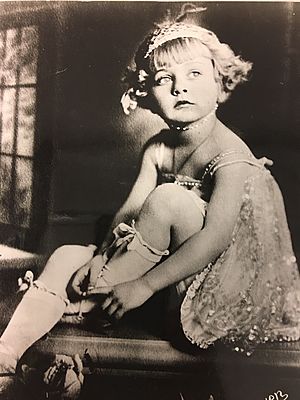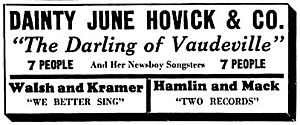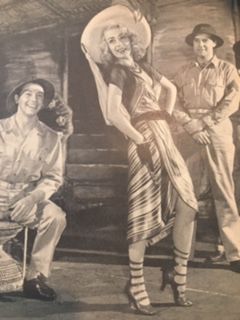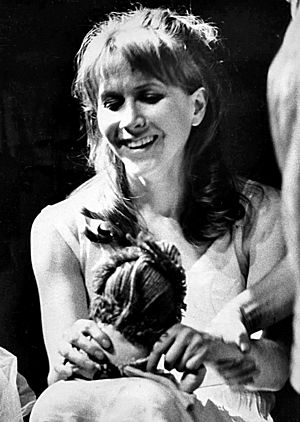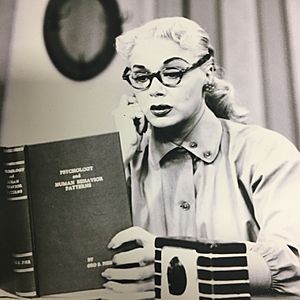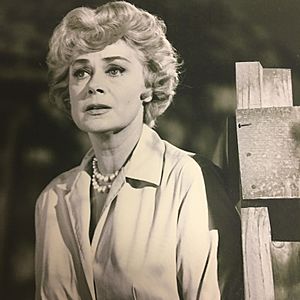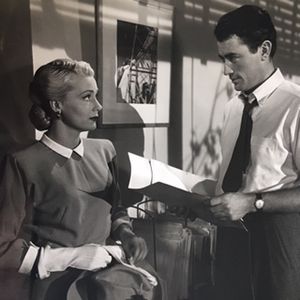June Havoc facts for kids
Quick facts for kids
June Havoc
|
|
|---|---|

Havoc c. 1944
|
|
| Born |
Ellen Evangeline Hovick
November 8, 1912 Vancouver, British Columbia, Canada
|
| Died | March 28, 2010 (aged 97) Stamford, Connecticut, U.S.
|
| Occupation |
|
| Years active | 1918–1995 |
| Spouse(s) | Bobby Reed (a.k.a. Weldon Hyde) (m. 1928; div. 193?) Donald S. Gibbs
(m. 1935; div. 1942)William Spier
(m. 1948; died 1973) |
| Children | 1 |
| Parent(s) |
|
| Relatives | Gypsy Rose Lee (sister) |
| Signature | |
June Havoc (born Ellen Evangeline Hovick; November 8, 1912 – March 28, 2010) was a talented Canadian-American actress, dancer, and stage director. She also wrote books about her life and plays. June Havoc started performing in vaudeville as a child. Later, she became famous on Broadway and in Hollywood movies. She also directed plays both on and off-Broadway. Her last TV appearance was in 1990 on the show General Hospital. She also appeared as herself in interviews in 1997 and 1999.
Contents
Early Life and Childhood Fame
Ellen Evangeline Hovick was born in Vancouver, British Columbia, Canada. For many years, people thought she was born in 1916. However, June Havoc later said that 1912 was likely her real birth year. She wasn't sure herself because her mother made different birth certificates for her and her sister. This was done to get around child labor laws at the time. June's career in show business began when she was very young. She was known as "Baby June."
Her sister, Gypsy Rose Lee, was also a famous entertainer. Their mother was Rose Thompson Hovick. Their father, John Hovick, worked for a newspaper.
A Star's Journey: Career Highlights
Vaudeville Days
After her parents divorced, June and her sister earned money by performing in vaudeville. Vaudeville was a popular type of entertainment with many different acts. June was often more talented than her sister, Louise. "Baby June" got an audition with Alexander Pantages, who built theaters across the western United States. Soon, she was a vaudeville star and appeared in silent Hollywood movies. She couldn't speak until she was three, but silent films didn't need talking! She would cry for the cameras when her mother told her their dog had died.
In 1928, when June was 16, she ran away to marry Bobby Reed, a boy from her vaudeville act. She wanted to escape her very controlling mother. Her mother tried to stop the marriage, but June married him anyway. She left her family and the act. The marriage didn't last, but they remained friends.
Shining on Film and Stage
June changed her last name to Havoc, which was a twist on her birth name. In 1936, she got her first role on Broadway in a show called Forbidden Melody. In 1940, she was amazing as Gladys Bumps in the musical Pal Joey. This show also featured Gene Kelly and Van Johnson. Their success led Havoc, Johnson, and Kelly to Hollywood.
June made her first film in 1942. She then switched between making movies and performing on Broadway. From 1942 to 1944, she was in 11 films. These included My Sister Eileen and No Time For Love. She returned to Broadway in 1943–44 in the musical Mexican Hayride. She won an award for her great performance in this show.
In 1944, June took over the main role in the musical Sadie Thompson. Another famous actress, Ethel Merman, had left the show. June's performance was highly praised. Critics called her "most enjoyable" and "surprisingly effective." Even though the show itself had mixed reviews, June's acting was a big success.
In Hollywood, June often played important supporting roles. She acted alongside popular musical stars like Alice Faye and Betty Grable. She also starred in several mystery films, known as film noir. One of her most famous movie roles was in the Oscar-winning film Gentleman's Agreement (1947). In this movie, she played a secretary who was Jewish but kept it a secret.
In the late 1950s, June decided to act in classic plays. She performed in The Infernal Machine and A Midsummer Night's Dream. Critics loved her performances, calling her "delightful" and "forceful."
June and her sister, Gypsy Rose Lee, were often asked for money by their mother. This continued until their mother passed away in 1954. After her death, the sisters could finally write about their lives. Gypsy's book, Gypsy, became a famous Broadway musical. June didn't like how she was shown in the musical. This caused some disagreements between the sisters. However, they made up before Gypsy's death in 1970.
In 1960, June Havoc joined a special theater group that toured the world. This group was created by President Dwight D. Eisenhower. They performed plays in Europe, the Middle East, and Latin America. June acted in plays like The Skin of Our Teeth and The Miracle Worker.
June's first book, Early Havoc, came out in 1959. It told the story of her life up to 1933. The book described a very tough dance marathon contest she was in. An actress named Julie Harris read the book and encouraged June to write a play about the dance marathon. June had never written a play before, but she agreed. The play, Marathon ’33, opened on Broadway in 1963. June directed and choreographed the show herself. It earned four Tony nominations, including one for June for best direction.
June wrote more plays and another book called More Havoc. This second book was also praised by critics. They called her a "writer of consequence" and said the book was "vivid" and "painfully real."
In 1966, June starred in a Broadway revival of Dinner At Eight. A critic compared her to the famous actress Vivien Leigh. He praised her charming performance as the hostess of the dinner party.
In the late 1960s, June helped create a professional theater program in New Orleans. This program allowed high school students to see plays. June became the artistic director of The Repertory Theatre in New Orleans. She turned an old synagogue into a theater. She also started a program for teenagers and an acting school. In 1970, June performed in The Skin of Our Teeth again. At 58 years old, she even performed on a trapeze 60 feet above the audience!

In 1982, June Havoc took on the role of the mean "Miss Hannigan" in the famous Broadway musical Annie. She played the part until the show closed in 1983. Her last New York stage appearance was in 1995, at age 82. She starred in The Old Lady’s Guide to Survival. Her performance was named one of the best of the season. In 2002, at age 88, she performed in a play called Lifeboat Drill.
Television and Radio Appearances
June Havoc also performed on radio shows in the 1940s and 1950s. She was in full-length plays and popular mystery programs like Suspense.
In the 1950s, June often appeared on TV shows that presented different stories each week. She starred in her own weekly show called Willy from 1954 to 1955. In this show, June played Willa "Willy" Dodger, an unmarried lawyer with her own practice. This was quite modern for its time! The show was filmed in front of a live audience, just like I Love Lucy.
From the 1960s to 1990, June made guest appearances on many popular TV shows. These included The Untouchables, Murder She Wrote, and The Outer Limits. She also had a role on the soap opera General Hospital.
Personal Life and Interests
June Havoc was married three times. Her first marriage was at age 16 to Bobby Reed in 1928. Her second marriage was to Donald S. Gibbs in 1936. Her third marriage was to William Spier, a radio and TV director. They were married from 1948 until his death in 1973.
June had one daughter, April Rose Hyde, born in 1932. April later became an actress known as April Kent. She appeared in films like The Incredible Shrinking Man. Sadly, April passed away in 1998, before her mother.
In 1947, June Havoc joined a group called the Committee for the First Amendment. This group supported freedom of speech in the film industry. June and other famous actors traveled to Washington, D.C. to protest. They believed people should be free to express their ideas without fear.
In 1967, June started a program called Youthbridge. It offered theater training to teenagers in Bridgeport, Connecticut. She was the director and helped raise money for the program.
In the mid-1970s, June bought an old train depot and other historic buildings in Wilton, Connecticut. She worked hard to restore these buildings, creating a charming area called Cannon Crossing. Today, it's a popular place with shops, galleries, and restaurants. June also set aside half of the land for rescued animals. She loved animals very much and her homes were a safe place for many geese, donkeys, cats, and dogs.
June Havoc was a supporter of the Democratic Party.
Later Years and Legacy
June Havoc passed away at her home in Stamford, Connecticut, on March 28, 2010. She was believed to be 97 years old.
Honors and Awards
June Havoc received many awards for her work:
- In 1944, she won the Donaldson Award for best supporting actress in a musical (Mexican Hayride).
- In 1960, she received two stars on the Hollywood Walk of Fame. One was for her movies and the other for her TV work.
- In 1964, she was nominated for a Tony Award for Best Direction of a Play for her play Marathon '33. She was the first American woman to be nominated for a Tony for directing a play.
- In 1971, she received a Humanitarian Award from Bridgeport University.
- In 1976, she was nominated for a Drama Desk Award for her role in Habeas Corpus.
- In 2000, June Havoc was honored by being inducted into the American Theatre Hall of Fame.
Lasting Impact
The June Havoc Theatre in New York City was named after her in 2003. This shows her lasting impact on theater.
June Havoc's papers, including her writings and other materials, are kept at Boston University. This collection helps people learn more about her amazing life and career.
Selected Stage Work
(All shows on Broadway unless noted otherwise.)
Acting Roles
- The Merry Widow (1936)
- Forbidden Melody (1936)
- Pal Joey (1941)
- Mexican Hayride (1944)
- Sadie Thompson (1944)
- The Infernal Machine (1958)
- A Midsummer Night's Dream (1958)
- Dinner at Eight (1966)
- The Skin Of Our Teeth (1970)
- Annie (1982–83)
- The Old Lady's Guide to Survival (1995)
Directing Roles
- Marathon '33 (1963)
- A Delicate Balance (1967)
- The Threepenny Opera (1970)
- The Women (1970)
- A Streetcar Named Desire (1970)
Selected Filmography
Feature Films
- Four Jacks and a Jill (1942)
- My Sister Eileen (1942)
- No Time for Love (1943)
- Hello, Frisco, Hello (1943)
- Brewster's Millions (1945)
- Intrigue (1947)
- Gentleman's Agreement (1947)
- The Iron Curtain (1948)
- When My Baby Smiles at Me (1948)
- Red, Hot and Blue (1949)
- Chicago Deadline (1949)
- The Story of Molly X (1949)
- Mother Didn't Tell Me (1950)
- Once a Thief (1950)
- Follow the Sun (1951)
- Lady Possessed (1952)
- Three for Jamie Dawn (1956)
- Can't Stop the Music (1980)
- A Return to Salem's Lot (1987)
Selected Television Work
- The Milton Berle Show (1949)
- Robert Montgomery Presents (1950)
- Celanese Theatre (1952)
- Willy (1954–1955)
- The Untouchables (1960)
- The Outer Limits (1964)
- McMillan and Wife (1971)
- Murder She Wrote (1987, 1989)
- General Hospital (1990)
Selected Radio Work
- Theatre Guild on the Air (1946)
- Suspense (1947, 1949)
- Hollywood Fights Back (1947)
Recordings
- Mexican Hayride (original Broadway cast album) (1944)
- Cole Porter's Can-Can / Mexican Hayride / The Pirate (original cast selections cd 2007)
Literary Works
Plays Written by June Havoc
- Marathon '33 (1963)
- I, Said The Fly (1973)
- Oh Glorious Tintinnabulation (1974)
- An Unexpected Evening with June Havoc (1983)
Books Written by June Havoc
- Early Havoc (1959)
- More Havoc (1980)
Images for kids


